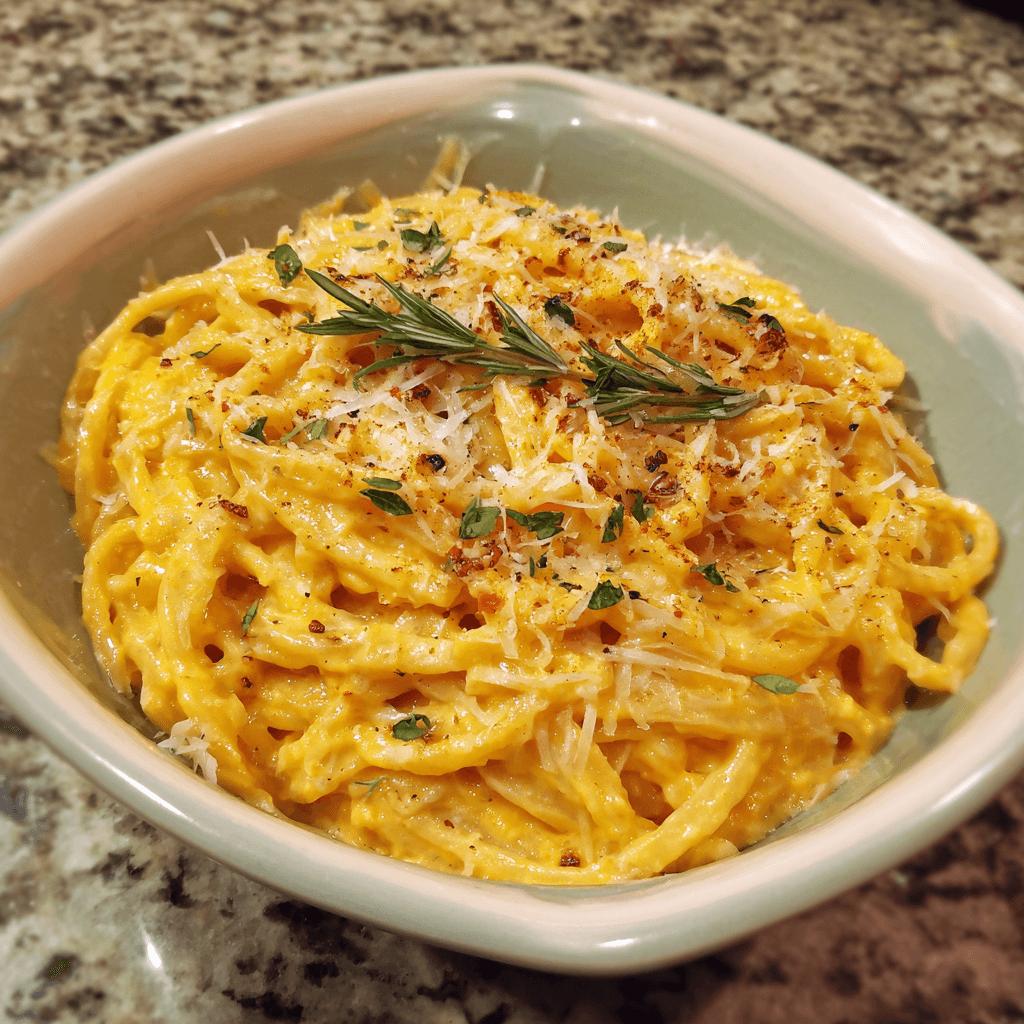Introduction
Butternut Squash Alfredo is a creamy, comforting pasta dish that reimagines the classic Italian-American favorite with a healthier, vibrant twist. By substituting traditional heavy cream with pureed butternut squash, this recipe retains all the richness and depth of flavor while adding a boost of nutrients and natural sweetness. Whether you’re looking for a cozy weeknight dinner or a crowd-pleasing centerpiece for your next gathering, Butternut Squash Alfredo offers a delicious way to enjoy a beloved comfort food in a more wholesome way.
The History
Alfredo sauce, known as salsa Alfredo, originated in early 20th-century Rome when restaurateur Alfredo di Lelio created a simple yet indulgent sauce made from butter, Parmesan cheese, and pasta water. The dish gained popularity in the United States after American celebrities brought it back from their European travels. Over time, the original recipe evolved into the thick, creamy version most commonly found today in American restaurants, often incorporating heavy cream.
Butternut Squash Alfredo is a modern reinterpretation, likely born from the rise of health-conscious eating and plant-based cooking trends. Chefs and home cooks alike began experimenting with vegetable-based sauces to replicate the texture and creaminess of traditional Alfredo without the saturated fat and calories. Butternut squash became a popular choice due to its naturally sweet, nutty flavor and smooth consistency when roasted and pureed.
Ingredients Breakdown
Here’s a detailed look at the key ingredients used in Butternut Squash Alfredo:
- Butternut Squash – Provides natural sweetness, vibrant color, and a creamy texture once roasted and blended.
- Garlic – Adds aromatic depth and savory complexity.
- Onion – Offers a subtle base flavor that enhances the overall richness.
- Olive Oil or Butter – Used for sautéing aromatics and building flavor.
- Vegetable or Chicken Broth – Helps thin out the sauce to the desired consistency and adds additional layers of flavor.
- Parmesan Cheese (or Nutritional Yeast) – Brings a salty umami quality; nutritional yeast provides a vegan alternative with similar cheesy notes.
- Fresh Nutmeg – Enhances the natural sweetness of the squash and complements its earthy undertones.
- Salt and Pepper – Essential for seasoning and balancing flavors.
- Pasta – Typically fettuccine, but other types like penne, rigatoni, or even gluten-free options work well.
- Optional Add-ins – Kale, spinach, roasted garlic, caramelized onions, or crispy pancetta can add texture and extra flavor.
Step-by-Step Recipe
- Prep the Squash: Preheat oven to 400°F (200°C). Peel and cube the butternut squash, toss with olive oil, salt, and pepper, then spread on a baking sheet. Roast for 25–30 minutes until tender and lightly caramelized.
- Cook the Aromatics: In a large skillet, sauté minced garlic and diced onion in olive oil or butter until softened and fragrant, about 5 minutes.
- Blend the Sauce: Transfer roasted squash to a blender or food processor. Add sautéed garlic and onion, a splash of broth, Parmesan or nutritional yeast, a pinch of nutmeg, and blend until smooth. Adjust consistency with more broth as needed.
- Cook the Pasta: Boil salted water and cook pasta according to package instructions. Reserve a cup of pasta water before draining.
- Combine Everything: Toss hot pasta in the sauce, adding pasta water as needed to reach a creamy consistency. Season with salt and pepper to taste.
- Garnish and Serve: Top with freshly grated Parmesan, chopped parsley, a drizzle of olive oil, or crushed red pepper flakes for heat.
Tips
- Use pre-cut squash if short on time, though roasting your own always yields better flavor.
- Don’t over-blend the sauce—some texture can be nice, especially if serving with heartier pastas.
- Season in layers—add salt and pepper throughout the process to build flavor.
- Make ahead: The sauce can be prepared up to two days in advance and stored in the fridge or frozen for up to a month.
- Use pasta water to adjust the sauce’s thickness and help it cling to the noodles.
- Toast the nutmeg lightly in a dry pan before grinding for an intensified flavor profile.
Variations and Customizations
- Dairy-Free Alfredo: Use nutritional yeast instead of Parmesan and substitute dairy butter with coconut oil or vegan margarine.
- Spicy Kick: Stir in red pepper flakes or a dash of hot sauce to give the sauce some heat.
- Protein-Packed: Add shredded cooked chicken, grilled shrimp, or cubes of roasted tofu or tempeh.
- Greens Galore: Fold in sautéed kale, spinach, or arugula just before tossing with pasta.
- Mushroom Magic: Sauté cremini or shiitake mushrooms alongside the onions for an umami-rich upgrade.
- Coconut Cream Twist: For a tropical-inspired version, stir in a few tablespoons of full-fat coconut milk or coconut cream.
- Bacon or Pancetta: Crisp up some bacon or pancetta and sprinkle on top for added crunch and smokiness.
Health Considerations and Nutritional Value
Traditional Alfredo sauce is high in saturated fat and calories due to the heavy use of butter and cream. Butternut Squash Alfredo significantly reduces both while boosting fiber, vitamins, and antioxidants. Here’s how it stacks up nutritionally:
- Vitamin A: Rich in beta-carotene, which supports eye health and immune function.
- Fiber: Promotes digestive health and helps regulate blood sugar levels.
- Low in Fat: Naturally lower in unhealthy fats, especially when using minimal olive oil and omitting dairy.
- Gluten-Free Option: Easily made gluten-free by using gluten-free pasta or spiralized vegetables like zucchini or sweet potatoes.
- Lower Calories: Replacing cream with squash cuts hundreds of calories per serving without sacrificing satisfaction.
Overall, this dish is a nutrient-dense alternative that satisfies comfort cravings while supporting long-term wellness goals.
Ingredients
- 1 medium butternut squash (about 2 lbs), peeled and cubed
- 2 tbsp olive oil or unsalted butter
- 1 small onion, finely chopped
- 2 cloves garlic, minced
- 1/2 cup vegetable or chicken broth
- 1/2 cup grated Parmesan cheese (or nutritional yeast for vegan option)
- 1/4 tsp freshly grated nutmeg
- Salt and black pepper to taste
- 12 oz fettuccine or preferred pasta
- Fresh parsley or chives for garnish (optional)
Directions
- Preheat oven to 400°F (200°C).
- Toss cubed butternut squash with 1 tablespoon of olive oil, salt, and pepper. Spread on a baking sheet and roast for 25–30 minutes until tender and golden brown.
- In a skillet over medium heat, warm remaining olive oil or butter. Sauté onion until translucent, then add garlic and cook another minute.
- Add roasted squash to a blender or food processor. Pour in sautéed aromatics, broth, Parmesan or nutritional yeast, and nutmeg. Blend until










